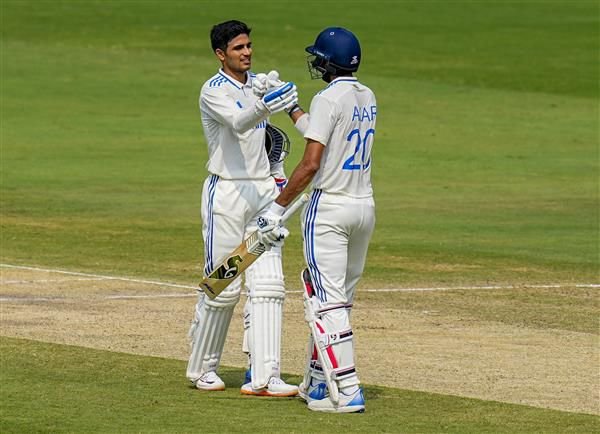Ahmedabad, Feb 1 (PTI) : Those who watched Shubman Gill’s sublime hundred on Wednesday would struggle to decide which of his shots was the most memorable. Was it the languid cover drive in the first over that got him going or the frequent nonchalant flicks that sailed over the substantial boundaries at the spectacular stadium? Was it the delicate late cut towards the end of the innings when the temptation would have been to go hard at each ball or the straight hits off the spinners after dancing down the pitch?
The most pleasing aspect of Gill’s 126 off 63 balls – with 12 fours and seven sixes – was that every shot seemed more eye-catching than the previous one, with no hoicks across the line or too much premeditated movement before the ball arrived. His tall frame and easy reach makes him a treat to watch, and he has made a habit of making good form count across formats, as he notched up the highest individual T20I score by an Indian batsman.
It was a series decider, but despite Ishan Kishan’s early dismissal, there was only one winner. The match was over as a contest inside two overs of the chase, with New Zealand reduced to 5/3. It soon became 21/5 and only the margin of victory was left to be decided. That was eventually 168 runs, sealed with almost eight overs left in the game, as Mitchell Santner’s team was bundled out for 66 in pursuit of 235. A less charitable way of looking at it would be that they fell short of Gill’s score by 60 runs.
The result maintained India’s enviable record in bilateral white-ball series, especially in T20 cricket, even though this dominance has not been translated into success at major ICC tournaments.
It wasn’t the best night for the Kiwis, with their normally high fielding standards falling more than a few notches. But it was an occasion for the hosts to raise their game in a must-win game. Apart from the batting and bowling, Suryakumar Yadav’s spectacular catching – two grabs high over his head at slip, and one right on the boundary where he had to display awareness and balance – showed that India were up for the match.
After a flurry of boundaries from Gill to start the match, it was Rahul Tripathi who took on the mantle with his improvisation and constant fidgeting around the crease, as the second-wicket partnership reached 50 in 28 balls. Tripathi’s 44 off 22 balls set the stage, and Gill’s subsequent partnerships with Yadav and Hardik Pandya were responsible for taking India to 234/4 in 20 overs. The captain, especially, was in the unfamiliar situation of being overshadowed in terms of stroke-play by his batting partner as the stand reached three figures in merely 41 balls.
Spinners Santner and Ish Sodhi, and other part-timers, had made life difficult for Indian batsmen on helpful pitches in the first two games, but on a truer surface in Ahmedabad, were taken to the cleaners.
In reply, the Indian seamers – Pandya, Arshdeep Singh, Umran Malik and Shivam Mavi – made good use of the bounce and reasonable pace on offer to run through the visitors.
But even without the start they suffered, New Zealand would have struggled to get the target after what Gill & Co. showcased in the first part of the match. The Punjab batsman became only the fifth Indian batsman to score hundreds in all three international formats.
And he almost seemed to do that with the coaching manual in one hand, such was the poise and control he exuded in the middle. It hadn’t been long since he scored a double ton against the same team in 50-over cricket, and even though the deliveries at his disposal came down drastically in the T20 format, there was nothing frenetic about Gill’s batting.
India reached 58 by the time the Powerplay was over and had gone past 100 before the halfway mark of the innings. In the last 10 overs, there came a stage when the Kiwi bowlers would have felt as if they were bowling in a highlight reel, as almost every other delivery seemed to be going to the boundary or over it.
Gill’s ability to clear the boundaries with almost ridiculous ease is a newly-added skill to his game, and could make him a stalwart in all forms of the game. His purple patch is good news for India with the marquee Test series against Australia just a week away.
As far as the other personnel in the team are concerned, Tripathi showed what trust from the team management and a willingness to play without fear can achieve. The Maharashtra batsman hadn’t had a fruitful few matches, but that didn’t prevent him from imposing himself on proceedings after Kishan had fallen leg-before in the second over.
On the bowling front, Pandya continued taking the new ball and having a good time. He got early wickets and finished with figures of 4-16. Arshdeep got the lateral movement and Malik was a threat with his extra pace. In fact, it was a rare occasion on home soil when spinners were hardly needed to chip in.
Since India’s ouster from the T20 World Cup last year, Pandya has been at the helm in the shortest format, though he hasn’t been formally appointed skipper. The senior pros – Rohit Sharma, Virat Kohli, KL Rahul and Jasprit Bumrah – have not featured, but their absence has hardly been felt. It can be seen as a big tick in favour of Pandya’s captaincy credentials.
“I try to read the situation and what’s required at that moment, and not have preconceived ideas. A lot of time I back my gut feeling,” he said after the game. “I take calls on my own because I like to take the ownership.”
Despite success in bilateral series, India have been found wanting in major events, but Pandya said “we want to normalise these pressure games, and hopefully we can do better at bigger stages.”







